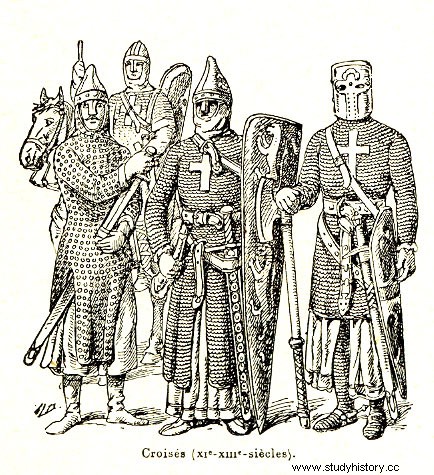- Holy places and relics occupied an important place in medieval Christianity. The Church, which had already justified the holy war during the Reconquista , will initiate several crusades all aimed at liberating the holy land, Jerusalem.
- Always stemming from a papal bull, the call to the crusade is relayed by the clergy who present it as a holy and noble objective, a duty for all Christians:it is accompanied by an indulgence (the forgiveness of sins). This is how the kings, nobles, knights and peasants of Europe, and especially of France, fervently committed themselves to religion and glory under the banner of the pope, thus strengthened in his power.
- The barbarity shown by all the campaigns divides Christianity and stirs up anger in the Middle East.
1096 - 1272

Characters
Urban II
Eugene III
Louis VII
Conrad III
Gregory VIII
Saladin
Richard I st Lionheart
Philip II Augustus
Frederic I st Barbarossa
Honorius III
Frederick II
Innocent IV
Louis IX Saint Louis
Procedure
From 1096 to 1099
Initiated by Pope Gregory VII, the project of the first crusade was taken up in 1095 by Pope Urban II at the Council of Clermont, who promised plenary indulgence to the crusaders. Many pilgrims leave from France and Germany. Many die on the way and many Jews are massacred. However, the four European armies found themselves in front of Constantinople, liberated the territories taken by the Turks and then continued their journey until the conquest of Jerusalem, which became a Frankish kingdom in 1099. Along the way, many nobles colonized Asia Minor and Syria (creation of counties, including the county of Edessa), opening the ports to Western trade.
From 1147 to 1149
The Turkish governor Zengi takes over the county of Edessa in 1144, and Pope Eugene III calls for a new crusade. The King of France Louis VII and the Germanic Emperor Conrad III respond to it. The pilgrimage to Jerusalem is deadly for the crusaders, who are mainly civilians and not soldiers. After helping the Baron of Jerusalem, the kings embark without having tried to free Edessa. At the same time, Sultan Saladin unifies Egypt and Syria, recovering the former Crusader colonies.
From 1189 to 1192
In order to ward off Saladin, who seized Jerusalem in 1187, Pope Gregory VIII calls for the Third Crusade. Richard I (England), Philip II (France) and Frederic I st (Germanic Empire) take the cross from 1188 and raise the saladine tithe to finance the crusade. The accidental death of Frederic I leaves the two kings to conquer Acre with their army. After the departure of Philip II, Richard I continued the battle without succeeding in delivering Jerusalem. Thus in 1192 he signed peace agreements with Saladin, allowing Christian and Muslim pilgrims to travel safely.
From 1202 to 1204
The tensions following the schism of the Church of East and West in 1054 lead to the diversion of the IV th crusade called by Innocent III for commercial purposes. It ends with the sacking of Constantinople in 1204.
From 1228 to 1229
Pope Honorius III urges German Emperor Frederic II to respect his crusade vow; the latter, excommunicated after having waited too long, embarks and has Jerusalem ceded to him without shedding a drop of blood.
From 1248 to 1254
In 1244, Saladin's forces retook Jerusalem. Pope Innocent IV therefore calls for the crusade which will be led by Louis IX from 1248. The crusaders conquer Damietta, but in 1250, the king is captured by the Mamluks who have become masters of Egypt. Freed against the retrocession of Damietta, Louis IX devoted himself to the fortification of coastal strongholds. Less than ten years after the king's return, almost all of the Latin strongholds were taken over.
From 1268 to 1272
Louis IX takes back the cross and tries to convert the ruler of Tunis to Christianity. While his efforts bear fruit, he dies of an epidemic of plague. His brother, Charles of Anjou, signs advantageous agreements with Tunis for the kingdom.
The Mamluk Sultan Qalaun undertakes the conquest of all the Latin states of the Levant which the West can no longer sustain.
Consequences
- In addition to territorial expansion, the discovery of the Orient contributed to renewing Mediterranean trade (especially with highly prized silk and spices). The Crusaders brought back riches from their travels, but the storytellers also brought back a new culture and imagery, the East being far more advanced than the West in many respects – notably medicine.
- Nevertheless, the Crusades tore the Church apart, divided between supporters and opponents of the Crusades, like the order of Cluny, who would prefer a peaceful conversion.
- By using the crusade for its own account (crusade against the Albigensians, 1207-1208) or for political ends, the Church served and disunited itself:this would be one of the main triggers of the schism of 1054.
